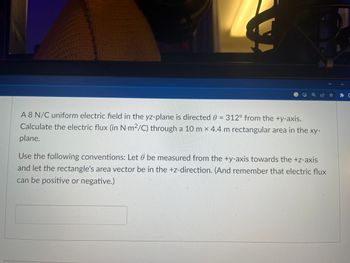Question

Transcribed Image Text:A 8 N/C uniform electric field in the yz-plane is directed 0 = 312° from the +y-axis.
Calculate the electric flux (in N-m²/C) through a 10 m x 4.4 m rectangular area in the xy-
plane.
Use the following conventions: Let 0 be measured from the +y-axis towards the +z-axis
and let the rectangle's area vector be in the +z-direction. (And remember that electric flux
can be positive or negative.)
Expert Solution
This question has been solved!
Explore an expertly crafted, step-by-step solution for a thorough understanding of key concepts.
This is a popular solution
Trending nowThis is a popular solution!
Step by stepSolved in 3 steps with 2 images

Knowledge Booster
Similar questions
- could you solve (d) only please?arrow_forwardWe have calculated the electric field due to a uniformly charged disk of radius R, along its axis. Note that the final result does not contain the integration variable r: R. Q/A 2€0 Edisk (x² +R*)* Edisk perpendicular to the center of the disk Uniform Q over area A (A=RR²) Show that at a perpendicular distance R from the center of a uniformly negatively charged disk of CA and is directed toward the disk: Q/A radius R, the electric field is 0.3- 2€0 4.4.1barrow_forwardA uniform electric field of magnitude 5.5 x 104 N/C passes through the plane of a square sheet with sides 9.0 m long. Calculate the flux (in Nm²/C) through the sheet if the plane of the sheet is at an angle of 30° to the field. Find the flux for both directions of the unit normal to the sheet. unit normal with component parallel to electric field Nm²/C unit normal with component antiparallel to electric field Nm²/c Additional Materialsarrow_forward
- A flat sheet is in the shape of a rectangle with sides of lengths 0.400 m and 0.600 m. The sheet is immersed in a uniform electric field of magnitude 55.0 N/C that is directed at 20 degrees from the plane of the sheet (Figure 1). Find the magnitude of the electric flux through the sheet. Express your answer with the appropriate units.arrow_forwardA Gaussian surface in the form of a hemisphere of radius R = 5.84 cm lies in a uniform electric field of magnitude E = 2.20 N/C. The surface encloses no net charge. At the (flat) base of the surface, the field is perpendicular to the surface and directed into the surface. (a) What is the flux through the base? ______________N · m2/C(b) What is the flux through the curved portion of the surface? _______________N · m2/Carrow_forwardThe square surface shown in the figure measures 3.4 mm on each side. It is immersed in a uniform electric field with magnitude E = 1400 N/C and with field lines at an angle of 35° with a normal to the surface, as shown. Take that normal to be "outward," as though the surface were one face of a box. Calculate the electric flux through the surface. Normal 4 Number i Unitsarrow_forward
- Problem 2 Consider the Gaussian surface shown in Figure 2. A uniform external electric field E, having magnitude 3.20 x 103 N/C and parallel to the xz plane with an angle of 36.87° measured from the +x axis toward the +z axis, enters through face 1 (back face). In addition, a uniform electric field E, of magnitude 6.40 x 103 N/C traveling in the same direction as E, , flows outwardly through face 2 (front face). 0,45 m 0,30 m En 0.50 m Figure 2. Gaussian surface in the form of a prism through which two fields pass.arrow_forwardThe square surface shown in the figure measures 4.2 mm on each side. It is immersed in a uniform electric field with magnitude E = 1900 N/C and with field lines at an angle of 35° with a normal to the surface, as shown. Take that normal to be "outward," as though the surface were one face of a box. Calculate the electric flux through the surface.arrow_forward
arrow_back_ios
arrow_forward_ios